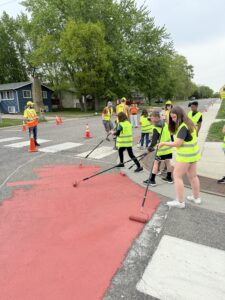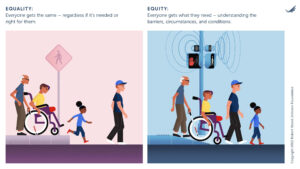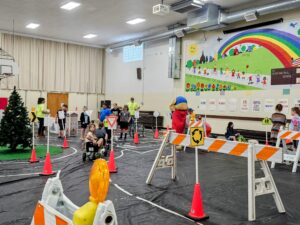What is Safe Routes to School (SRTS)?
Safe Routes to School (SRTS) is an effort to improve walking and bicycling conditions for youth and to encourage more active lifestyles. SRTS programs improve safety, reduce traffic, and improve air quality near schools through a multidisciplinary approach that is structured around the 6 Es.
Additional information can be found on the Minnesota Safe Routes to School website.
Equity
Prioritizing positive outcomes for students from lower-income households; Black, Indigenous, and other students of color; students with disabilities; and other students who face disproportionate barriers to walking, biking, and rolling to school. Equity in SRTS means that every student is able to safely, comfortably, and conveniently walk and bike to school, regardless of race, cultural identity, tribal affiliation, immigrant or refugee status, language, gender or sexual identity, income, religion, and whether or not a student receives special education, has a physical or mental disability, or is homeless or highly mobile.
Equity recognizes that different people have different barriers to living healthy, fulfilled lives. In order to allow people to get the same outcome, we need to understand the different barriers and opportunities that affect different groups and craft our policies, programs, and overall approaches with those various challenges and needs in mind.
Equity allows resources to be provided on the basis of need. Communities disproportionately impacted by safety, health, or transportation access inequities are provided appropriate resources to address their individual needs. Therefore, resource allocation may differ between communities.

Pleasantview Elementary School students painting the pavement as part of a SRTS demonstration project in Sauk Rapids.
Engagement
Working with students, families, school staff, and community members and organizations, especially those from priority equity groups, to create and implement SRTS initiatives. Successful SRTS efforts depend on an actively engaged team to find meaningful ways to contribute to building a culture of walking and bicycling in their community.
Engineering
Developing equity-focused changes to the built environment, designed and prioritized through community engagement. Engineering improvements focus on making changes to streets, trails, and sidewalks to improve walking and biking conditions. These improvements generally aim to reduce vehicle speeds, address conflict points, and provide fully accessible sidewalks and crossings near schools.
Education
Providing students and other community members, especially those from priority equity groups, with skills and knowledge about walking, biking, and rolling. Education programs aim to teach students safe walking and biking behaviors, help improve kids’ bike riding skills or provide information to families about different transportation options that are available. Education programs can also include driver safety campaigns in the vicinity of schools — partnering with police, community groups, or others.
Encouragement
Normalizing a culture of walking, biking, and rolling through incentive programs, events, and activities that center on priority equity groups. Encouragement events help inspire students and parents to try walking or biking to school, and they can help make active transportation part of the culture of the school community.
Evaluation
Measuring how SRTS initiatives are implemented (process evaluation) and what their impacts are (outcome evaluation), especially how initiatives engage with and support priority equity groups. By helping to identify specific issues and monitor trends over time, evaluation strategies ensure that SRTS initiatives are effective. Data collection should occur at the beginning of a SRTS program and then at periodic intervals over time.
Current Planning Efforts
There are currently no planning efforts underway at this time.
How to Get Involved
There are currently no planning efforts underway at this time.
Previous SRTS Planning Efforts
Saint Cloud APO staffers have been working with schools across the APO’s planning area to develop SRTS plans since the 2018-2019 school year. This has included planning efforts with St. Cloud School District ISD 742, Sauk Rapids-Rice School District ISD 47 as well as Sartell-St. Stephen ISD 748.
APO staff have continued to engage these community partners in ways to implement various components of the approved SRTS planning efforts.
Planning Grant Opportunities
The following is a list of several active transportation planning grant opportunities/solicitations in which schools and/or communities can apply to receive funding assistance to develop and implement SRTS efforts. For those interested in infrastructure grant opportunities, please consult the Grant Opportunities page.
SRTS Planning Assistance Grants
Solicitation Status: CLOSED.
The SRTS Planning Assistance grants are available to schools and communities to develop comprehensive SRTS plans. Plans are either completed by the respective regional development organization or a statewide SRTS consultant.
SRTS Boost Grants
Solicitation Status: CLOSED.
The SRTS Boost grant supports communities with existing plans or other comprehensive SRTS approaches to promote non-infrastructure projects for schools to keep walking and bicycling to school safe, easy, and fun for students.
Active Transportation Planning Assistance Grant
Solicitation Status: CLOSED.
The Active Transportation Planning Assistance Grant is a state program designed to help communities create active transportation plans with the help from a consultant. The intent of the program is to help more people safely walk, bike, and roll to destinations where they live, work, and play. These plans will:
- Analyze existing conditions.
- Engage the community.
- Identify ways to improve infrastructure.
- Identify ways to encourage active transportation.
MnDOT will award up to $1 million worth of consultant support each year from 2024 through 2026. Funding will not be provided directly to the applicant, instead, funds will be directed to a MnDOT selected consultant. No matching funds are required.
Eligible applicants include:
- Cities.
- Special park districts.
- Counties.
- Federally-recognized Tribal Nations.
- Regional Development Organizations.
- Metropolitan Planning Organizations.
- Non-profit organizations and other groups (with letter of support from local government who will own the plan), including not-for-profit higher learning institutions.






